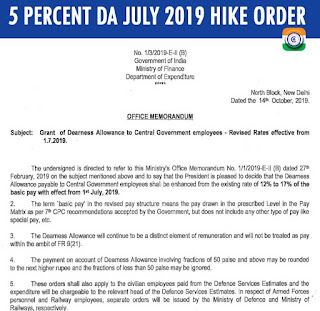Bonus: Modi government to raise the salary threshold from Rs.10,000 to 15,000, ceiling limit from Rs. 3500 to 4500

 An
estimate is two-thirds of the 6 crore organised sector workforce in the
country are eligible for the mandatory bonus given their salary levels.
Analysts, however, say that actual number of beneficiaries could be
less as many units practically circumvent the norm.Under Section 10 of Payments of Bonus Act, “every employer (as
defined in the Act) shall be bound to pay to every employee in respect
of every accounting year, a minimum bonus which shall be 8.33% of the
salary or wage earned by the employee during the accounting year”. All
factories and establishments employing 20 or more persons are expected
to pay the bonus compulsorily, provided the worker has worked in the
establishment for at least 30 days. Employees in Life Insurance
Corporation, seamen, dock workers and university employees are outside
the Act’s ambit.
An
estimate is two-thirds of the 6 crore organised sector workforce in the
country are eligible for the mandatory bonus given their salary levels.
Analysts, however, say that actual number of beneficiaries could be
less as many units practically circumvent the norm.Under Section 10 of Payments of Bonus Act, “every employer (as
defined in the Act) shall be bound to pay to every employee in respect
of every accounting year, a minimum bonus which shall be 8.33% of the
salary or wage earned by the employee during the accounting year”. All
factories and establishments employing 20 or more persons are expected
to pay the bonus compulsorily, provided the worker has worked in the
establishment for at least 30 days. Employees in Life Insurance
Corporation, seamen, dock workers and university employees are outside
the Act’s ambit.
In bonus to workers, cap on salary set to be raised: Financial Express News
Several lakhs of workers in the organised sector will benefit as the
Narendra Modi government is set to raise the salary threshold for
mandatory bonus for workers from Rs 10,000 a month at present to Rs
15,000 and the minimum bounty from an annual Rs 3,500 now to Rs 4,500.
The proposal, agreed to by employers’ associations at a recent meeting
of an inter-ministerial group, would require Parliament’s approval as
the Payments of Bonus Act, 1965, requires to be amended for this
purpose.
While the minimum bonus is a legal liability on the firms concerned,
whether or not they make a profits, these firms are also required to pay
the workers a higher bonus if their “allocable surplus” exceeds the
amount payable as minimum bonus, subject to a cap (20%) of the salaries.
If the new proposal takes affect, the maximum bonus payable by
profit-making ventures would be close to Rs 11,000 as against Rs 8,400
now.

The
salary ceiling for mandatory bonus eligibility was last fixed in 2007
and made effective retrospectively from April 1, 2006. While industry
associations demanded exempting sick units from the requirement of
paying bonus, trade unions have pitched for removal of the ceilings as
“profits are not capped”, official sources said. The unions also asked
for extending the benefit to workers under the Industrial Disputes Act,
they added.
The revision of the bonus eligibility and the amounts is being done
by factoring in the relevant price increases, the gauge used being the
consumer price index-industrial workers or CPI(IW). This index stayed in
the range of 6.4-12% since 2008. After hitting as high as 12% in 2010,
CPI(IW) has maintained a roller-coaster ride — it eased to 8.9% in 2011
before rising to 10.9% in 2013 and dropping again to 6.4% in 2014. In
the current calendar year, it has slowed almost consistently from 7.2%
in January to 5.8% in April.
 An
estimate is two-thirds of the 6 crore organised sector workforce in the
country are eligible for the mandatory bonus given their salary levels.
Analysts, however, say that actual number of beneficiaries could be
less as many units practically circumvent the norm.Under Section 10 of Payments of Bonus Act, “every employer (as
defined in the Act) shall be bound to pay to every employee in respect
of every accounting year, a minimum bonus which shall be 8.33% of the
salary or wage earned by the employee during the accounting year”. All
factories and establishments employing 20 or more persons are expected
to pay the bonus compulsorily, provided the worker has worked in the
establishment for at least 30 days. Employees in Life Insurance
Corporation, seamen, dock workers and university employees are outside
the Act’s ambit.
An
estimate is two-thirds of the 6 crore organised sector workforce in the
country are eligible for the mandatory bonus given their salary levels.
Analysts, however, say that actual number of beneficiaries could be
less as many units practically circumvent the norm.Under Section 10 of Payments of Bonus Act, “every employer (as
defined in the Act) shall be bound to pay to every employee in respect
of every accounting year, a minimum bonus which shall be 8.33% of the
salary or wage earned by the employee during the accounting year”. All
factories and establishments employing 20 or more persons are expected
to pay the bonus compulsorily, provided the worker has worked in the
establishment for at least 30 days. Employees in Life Insurance
Corporation, seamen, dock workers and university employees are outside
the Act’s ambit.
Although the country witnessed high inflation between 2009 and 2014,
the move to raise the bonus amounts comes at a time inflation has come
down (consumer price inflation is now below 5%). Consumer confidence is
yet to be restored to the pre-2008-09 levels, while in recent months
rural income growth has slowed.
Read at: Financial Express









